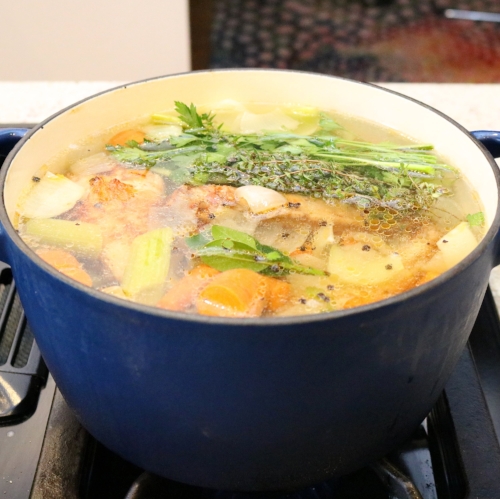Turkey Stock

It’s time to make stock! Whether you’re using it for gravy or stuffing, a high quality stock is the key to a better Thanksgiving dinner. This recipe takes some time (about 9 hours start to finish), but most of that time is spent just letting the stock bubble away on the stove.
Yield: ??? (see note below)*
This recipe is inspired by Anthony Bourdain’s Universal Dark Stock recipe in his book, Appetites.***
Ingredients
About 5 lbs. turkey wings and necks**
2 tablespoons tomato paste
2 tablespoons sunflower/canola oil
4 carrots, coarsely chopped
3 stalks celery, coarsely chopped
2 large onions, coarsely chopped
Small handful of thyme sprigs
Small handful of parsley sprigs
3 bay leaf
1 teaspoon black peppercorn
Large stock pot
Roasting pans
Instructions
Preheat the oven to 400°F. Spread one tablespoon of oil in a roasting pan. Add the turkey parts to the pan. Rub the turkey parts all over with the tomato paste. Roast the turkey in the oven for about 1 hour 20 minutes, turning the pieces occasionally. During the last 45 minutes of the turkey roasting time, add the remaining oil to another roasting pan and add the carrots, celery, and onion. Toss to combine. Add the pan of vegetables to the oven and roast for 45 minutes. Turn the vegetables occasionally and cook until they have lightly browned and are fragrant.
Turkey Stock. Starting out.
Transfer the roasted turkey (leave any excess oil in the pan) and vegetables to the stock pot and fill with water (fill it high, within an inch or so of the top of the pot). Add the parsley, thyme, bay leaf, and peppercorns to the pot, pushing the herbs under the water. Cook on high heat until the stock just begins to boil, then turn the heat down to medium-low to maintain a low simmer. Simmer and reduce the stock for a minimum of 6 hours and up to 9 hours. If you have have foam or oil gathering on the top of the water, remove it with a spoon.
Turkey Stock. After 3 hours of simmering.
Check the stock occasionally, but stirring isn’t really needed. If the level of water begins to reduce too far (such that vegetables and turkey are exposed), add more water to the pan to re-submerge everything (about 2 cups of water at a time). Don’t worry about “watering down your stock.” The fresh water will allow the stock to continue extracting out the good stuff, and it’ll still have time to reduce.
Turkey stock after simmering for about 8 hours. Time to strain!
When you’ve reached the end of your simmering time, pull out the larger pieces with tongs or a handheld strainer. Arrange another mesh sieve or fine colander over another stock pot or large bowl. Strain the stock and collect your reward in the container below. Repeat the straining, if you think the stock needs extra clarifying.
In order to keep your stock safe (and not in danger of growing bacteria), you need to make sure it cools down reasonably quickly. To do you this, either transfer to a number of smaller containers (so that you don’t have one giant block of hot liquid) and place in the fridge, or transfer the stock to a container that you can nest inside a larger container/pot filled with ice water. Once the stock is cooled down to at least room temperature, move it from the ice bath to the fridge. Store the stock in the fridge for up to 4 days or in the freezer for a few months (don’t forget to label your container).
When you’re ready to use the stock, skim off any fat that has collected on the top before use.
Turkey stock in a container. McZ uses the finest of duct tape labels.
Notes
*As for yield, it really depends on the size of your stock pot, the original amount of water, the simmering time, and how much water you add throughout the simmering process. Following the recipe above and the stock pot shown (i.e. very packed with veg and and turkey), and adding 4 additional cups of water to the pot during the simmer, I ended up with about 6 cups of very concentrated stock. I probably could have taken it off the stove sooner, started with a larger stock pot, or added some additional water during the process. But we’re primarily using this stock for gravy, so I let it go a little longer than I might otherwise.
**We’ve opted to use a mix of turkey parts here, but you can also use a leftover carcass from roasting a chicken or other similar cuts of raw chicken (wings, etc…in other words, go with what’s available and on sale). Additionally, if you’re using whole, raw wings like we did and want to remove some of the meat after roasting (for snacking or whatnot), that’s an option too. We sacrifice it all in the name of good stock though.
***Anthony Bourdain’s Appetites is a witty and fun cookbook full of great “basics” to buff up your kitchen skills. We highly recommend giving this book a try (the chicken salad recipe in here is delicious!).
Turkey stock from start to finish. Roasting turkey parts, followed by an 8-hour simmer.










